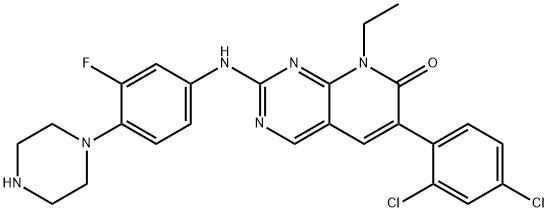1232030-35-1
 1232030-35-1 結構式
1232030-35-1 結構式
基本信息
CS-1943
FRAX 486
FRAX-486
6-(2,4-Dichlorophenyl)-8-ethyl-2-[[3-fluoro-4-(1-piperazinyl)phenyl]amino]pyrido[2,3-d]pyrimidin-7(8H)-one
6-(2,4-dichlorophenyl)-8-ethyl-2-((3-fluoro-4-(piperazin-1-yl)phenyl)amino)pyrido[2,3-d]pyrimidin-7(8H)-one
Pyrido[2,3-d]pyriMidin-7(8H)-one, 6-(2,4-dichlorophenyl)-8-ethyl-2-[[3-fluoro-4-(1-piperazinyl)phenyl]aMino]-
6-(2,4-dichlorophenyl)-8-ethyl-2-{[3-fluoro-4-(1-piperazinyl)phen Yl]amino}pyrido[2,3-d]pyrimidin-7(8h)-one FRAX597
| 報價日期 | 產品編號 | 產品名稱 | CAS號 | 包裝 | 價格 |
| 2024/11/08 | HY-15542B | FRAX486 FRAX486 | 1232030-35-1 | 5mg | 650元 |
| 2024/11/08 | HY-15542B | FRAX486 FRAX486 | 1232030-35-1 | 10mM * 1mLin DMSO | 730元 |
| 2024/11/08 | HY-15542B | FRAX486 FRAX486 | 1232030-35-1 | 10mg | 1100元 |
常見問題列表
|
PAK1 14 nM (IC 50 ) |
PAK2 33 nM (IC 50 ) |
PAK3 39 nM (IC 50 ) |
In vitro kinase assays using pure enzymes reveal IC 50 s for FRAX486 between 10-100 nM for PAK1-3, while the IC 50 of 779 nM for PAK4 is just below the micromolar range. For FRAX486, an EC 50 value of 500 nM has been reported from cells (5-50 fold higher than IC 50 ). FRAX486 (30 μM) inhibits endothelin-1 and -2 induced contractions. In WPMY-1 cells, FRAX486 (24 h) induces concentration-dependent (1-10 μM) degeneration of actin filaments. This is paralleled by attenuation of proliferation rate, being observed from 1 to 10 μM FRAX486. Cytotoxicity of FRAX486 in WPMY-1 cells is time- and concentration-dependent. FRAX486 significantly reduces the relative proliferation rate in the remaining populations of WPMY-1 cells. While 68% of solvent-treated (24 h) cells shows proliferation, proliferation rate after application of FRAX486 (1-10 μM, 24 h) ranges around 45%. FRAX486 (1-10 μM, 24 h) causes concentration-dependent degeneration of actin filaments. Actin filaments in solvent-treated control cells are arranged to bundles, forming long and thin protrusions, with elongations from adjacent cells overlapping each other. FRAX486 in concentrations of 1 μM causes partial loss of actin organization, including regressing degree of actin polymerization and degeneration of protrusions. FRAX486 in concentrations of 5 or 10 μM causes complete breakdown of filament organization, resulting in a rounded cell shape without protrusions.
FRAX486 displays the highest penetrance of blood–brain barrier in DISC1-knockdown C57BL/6 mice. Daily administration of FRAX486, but not that of vehicle, between P35 and P60 blocks the exacerbated spine loss during adolescence. In addition to the significant blockade of spine elimination, a trend of enhanced spine generation is observed by treatment with FRAX486. FRAX486 treatment ameliorates a deficit in prepulse inhibition in adulthood.